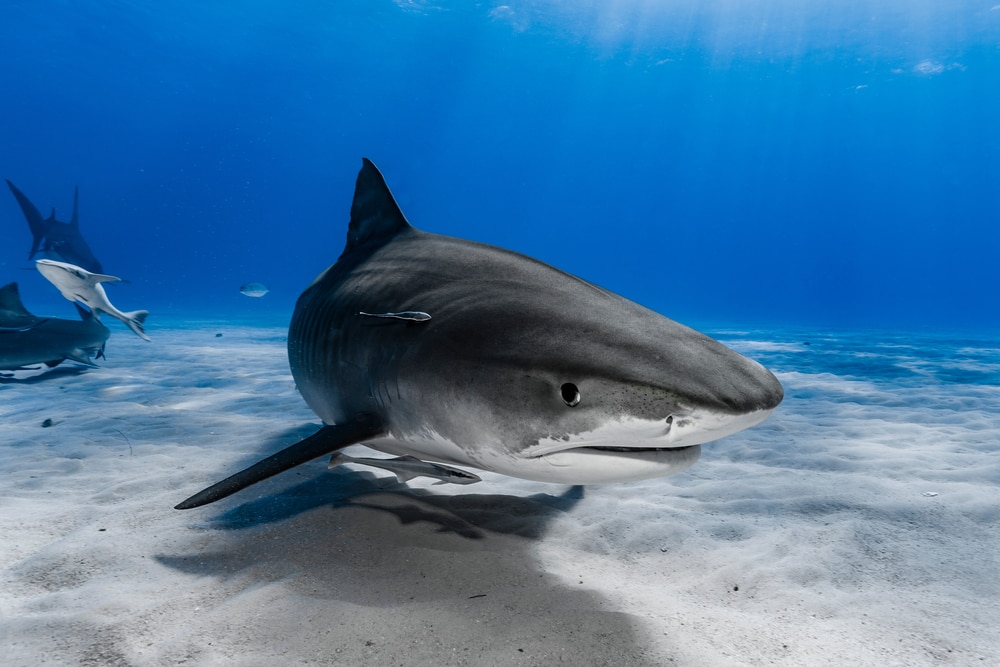Introduction
Are Sharks Fish Or Mammals: The captivating depths of Earth’s oceans hold within them a diverse array of inhabitants, each uniquely adapted to their underwater habitats. Among these enigmatic denizens, sharks, with their awe-inspiring presence and ancient lineage, have captured the imagination of humans for centuries. However, an intriguing question often arises: Are sharks fish or mammals? This query delves into the heart of biological classification and prompts a fascinating exploration of the intricate traits and characteristics that define these remarkable creatures.
The juxtaposition of sharks and mammals, two distinct groups within the animal kingdom, serves as a testament to the boundless diversity of life on our planet. On the surface, some shared traits might spark speculation, yet a closer examination of the fundamental aspects of shark biology unveils a wealth of insights that guide their proper classification.
Intriguingly, sharks occupy a unique niche within the broader taxonomy of life. Their position within the class Chondrichthyes, alongside rays and chimaeras, is a testament to their kinship with cartilaginous fish. Yet, this placement beckons a deeper exploration into the traits that align sharks with fish and differentiates them from mammals.
As we embark on this journey to unravel the mystery surrounding the classification of sharks, we will navigate through the realms of anatomy, physiology, reproduction, and evolution. By peering into the intricacies of their biological makeup, we will uncover the compelling evidence that unequivocally positions sharks within the fascinating realm of fish, painting a comprehensive portrait of these majestic and ancient creatures that have shaped the tapestry of life beneath the waves.

Is shark a fish or mammal?
Fish
Yes, sharks are fish, and they belong to the subclass “elasmobranch.”
A shark is a type of fish, not a mammal. Sharks belong to the class Chondrichthyes, which includes cartilaginous fish.
Unlike mammals, sharks lack mammary glands and do not nurse their young with milk. They reproduce by laying eggs or giving birth to live young, depending on the species.
Sharks are known for their cartilaginous skeletons, sharp teeth, and streamlined bodies adapted for life in the ocean. They are top predators in many marine ecosystems and play a crucial role in maintaining the balance of marine life.
While they share some characteristics with mammals, such as giving birth to live young, these features have evolved independently in sharks and are not indicative of mammalian traits.
Why is a shark not a mammal?
Despite names like ‘whale shark’, all sharks are fish and differ in many ways from mammals. For example, mammals breathe air through lungs, feed their young with milk and are warm-blooded. Sharks pass water over gills to breathe, don’t have mammary glands and (with the exception of mackerel sharks) are cold-blooded.
A shark is not a mammal primarily because it lacks several key characteristics that define mammals. Mammals are characterized by having mammary glands that produce milk to nourish their young. Sharks, on the other hand, do not possess mammary glands or produce milk.
Mammals also have a unique feature in their skeletal structure: they have bones, whereas sharks belong to a group of fish known as cartilaginous fish, which have skeletons made of cartilage rather than bone. Additionally, mammals are warm-blooded, regulating their body temperature internally, while sharks are cold-blooded, relying on their environment to regulate their body heat.
Reproduction is another distinguishing factor. Mammals give birth to live young, and their offspring often require significant parental care. Some shark species also give birth to live pups, but the reproductive process and care for offspring in sharks differ from typical mammalian reproduction.
The absence of mammary glands, the cartilaginous skeletal structure, cold-blooded nature, and distinct reproductive methods collectively differentiate sharks from mammals. These differences reflect the unique adaptations that have evolved in each group for their specific ecological niches.
Do sharks lay eggs or are they mammals?
There are over 500 species of shark living in waters around the world and the majority give birth to live young. The remainder are oviparous, meaning they lay eggs. Around 40 to 50 different shark species live permanently in or regularly visit the waters surrounding Britain.
Sharks typically do not give birth to live young. Instead, their reproductive methods can vary among different shark species. Some sharks are oviparous, which means they lay eggs. These eggs are often enclosed in protective cases that are commonly known as “mermaid’s purses” or egg cases. The eggs are deposited in the water, where they develop and hatch outside the mother’s body.
Contrary to mammals, sharks lack mammary glands and do not produce milk to nourish their young. This makes them fundamentally different from mammals in terms of reproductive strategies. While some shark species give birth to live pups after the eggs hatch internally, this mode of reproduction is still distinct from the mammalian reproductive process.
Sharks are not mammals. They are a type of fish with a diverse range of reproductive methods, including laying eggs, but they lack the defining characteristics that classify mammals, such as mammary glands and the ability to nurse their young with milk.

Are sharks basically fish?
Sharks are cartilaginous fish
Sharks are fish, but their skeletons are made of cartilage, not bone. Shark ancestors did have bones, but these evolved to become cartilage, which made sharks lighter and more buoyant. Scales, called denticles, cover sharks’ skin and help streamline their movement through water.
Yes, sharks are fundamentally considered fish. They belong to a class of fish known as Chondrichthyes, which includes cartilaginous fish like sharks, rays, and chimaeras. Sharks share many characteristics with other fish, such as having gills to extract oxygen from water and a streamlined body adapted for life in aquatic environments.
Sharks are unique within the fish class due to their specialized adaptations. They possess cartilaginous skeletons, a feature that sets them apart from bony fish that have skeletons made of bone. Additionally, sharks are apex predators and occupy a significant ecological role in marine ecosystems. Their distinct physiology, behaviors, and adaptations have led to their classification within a specific group of fish, but they remain an essential and diverse part of the fish kingdom.
Are dolphins fish?
Dolphins are mammals, not fish
Unlike fish, who breathe through gills, dolphins breathe air using lungs. Dolphins must make frequent trips to the surface of the water to catch a breath. The blowhole on top of a dolphin’s head acts as a “nose,” making it easy for the dolphin to surface for air.
No, dolphins are not fish. They are marine mammals belonging to the cetacean group, which includes whales and porpoises. Unlike fish, dolphins are warm-blooded, have lungs for breathing, and give birth to live young. They nurse their calves with milk produced by mammary glands, a characteristic that aligns them with other mammals.
Dolphins are known for their intelligence, social behavior, and complex communication skills. They have a streamlined body shape, similar to fish, which allows them to move efficiently through water. However, these similarities are the result of convergent evolution—distinct species evolving similar traits due to similar environmental pressures—rather than a classification based on shared ancestry.
In summary, dolphins are mammals, not fish. Their unique characteristics and evolutionary history place them within the diverse group of marine mammals, setting them apart from fish in terms of biology, behavior, and classification.
Are sharks classified as fish or mammals?
Sharks are classified as fish, not mammals. They fall within the class Chondrichthyes, a group of cartilaginous fish that includes sharks, rays, and chimaeras. While sharks share some similarities with mammals, such as giving birth to live young in some species, they lack the defining characteristics that categorize mammals.
One key distinction is the skeletal structure. Sharks, like other members of Chondrichthyes, have skeletons made of cartilage rather than bone. Mammals, on the other hand, possess bony skeletons. Additionally, sharks lack mammary glands, which are a hallmark of mammals. Mammary glands produce milk, a feature absent in sharks.
Sharks breathe using gills, extracting oxygen directly from water, whereas mammals have lungs and breathe air. Unlike mammals that regulate their body temperature internally, sharks are cold-blooded animals, meaning their body temperature is influenced by the surrounding environment.
While both sharks and mammals have evolved unique adaptations for their respective environments, the scientific classification places sharks firmly within the fish category. This classification is based on a combination of anatomical, physiological, and genetic traits that differentiate them from mammals and place them squarely within the diverse and fascinating realm of aquatic life.

Do sharks belong to the group of fish or the group of mammals?
Sharks unequivocally belong to the group of fish, not mammals. They are classified under the class Chondrichthyes, which encompasses cartilaginous fish. Despite sharing a few superficial similarities with mammals, such as live birth in some species, sharks are fundamentally distinct from mammals in multiple key aspects.
One of the most prominent differentiators is their skeletal composition. Sharks possess cartilaginous skeletons, which are composed of flexible cartilage, setting them apart from mammals that have bony skeletons. Sharks lack mammary glands, a defining feature of mammals responsible for producing milk to nourish their young. In contrast, sharks reproduce through various methods, including laying eggs and giving birth to live young.
Sharks exhibit characteristics typical of fish, such as gills for breathing, cold-blooded physiology, and a streamlined body designed for aquatic life. Unlike mammals that regulate their internal body temperature, sharks’ body heat is regulated by the environment.
While they may exhibit certain traits resembling mammals, the overall biological, anatomical, and reproductive characteristics categorize sharks firmly within the diverse and captivating realm of fish. This classification is rooted in rigorous scientific analysis and ensures that sharks are accurately placed in their evolutionary context as remarkable and ancient creatures of the sea.
Are sharks considered marine mammals or a type of fish?
Sharks are unequivocally considered a type of fish, rather than marine mammals. Sharks belong to the class Chondrichthyes, which encompasses cartilaginous fish. While they share aquatic habitats with marine mammals like dolphins and whales, sharks are distinct from mammals in several key aspects.
Unlike marine mammals, sharks lack mammary glands and do not nurse their young with milk. They reproduce through various methods, including laying eggs and giving birth to live young. These reproductive processes significantly differentiate them from marine mammals, which give live birth and nurse their offspring.
Another distinguishing factor is their skeletal composition. Sharks possess cartilaginous skeletons, made of flexible cartilage rather than bone. In contrast, marine mammals have bony skeletons.
Physiologically, sharks breathe through gills, extracting oxygen directly from water, whereas marine mammals breathe air through lungs.
While both sharks and marine mammals are integral components of aquatic ecosystems, their classification into distinct groups reflects their unique biological characteristics. Sharks are classified as fish based on their anatomical features and reproductive methods. This classification aids in our understanding of their evolutionary history and ecological roles, allowing us to appreciate their remarkable adaptations and contributions to marine environments.
Are the characteristics of sharks more similar to those of fish or mammals?
The characteristics of sharks are more similar to those of fish rather than mammals. Sharks belong to the class Chondrichthyes, a group of cartilaginous fish, which places them firmly within the fish category based on various biological and anatomical traits.
Physiologically, sharks share key features with other fish, such as gills that allow them to extract oxygen from water, a characteristic absent in mammals. Their cold-blooded nature, relying on the external environment to regulate body temperature, is another trait typical of fish.
Structurally, sharks possess cartilaginous skeletons, setting them apart from mammals that have bony skeletons. Unlike mammals, sharks lack mammary glands and do not nurse their young with milk; they utilize different reproductive methods, including laying eggs or giving birth to live young.
While certain shark species exhibit live birth, this reproductive trait has evolved independently in sharks and does not classify them as mammals. Overall, while there may be superficial similarities between sharks and mammals, such as some reproductive methods, the broader suite of characteristics align sharks more closely with fish. This distinction is essential for accurate biological classification and understanding the intricate diversity of life within our oceans.
Do sharks share more biological traits with fish or mammals?
Sharks share more biological traits with fish than with mammals. While some superficial similarities might exist between certain shark species and mammals, a comprehensive examination of their characteristics places them firmly within the realm of fish.
Physiologically, sharks exhibit key traits typical of fish. They possess gills that allow them to extract oxygen from water, enabling respiration without the need for lungs like mammals. Their cold-blooded physiology, where body temperature is regulated by the environment, is a defining characteristic of fish.
Anatomically, sharks’ cartilaginous skeletons align them with other fish. This contrasts with mammals, which have bony skeletons. Sharks also lack mammary glands, a feature exclusive to mammals, and do not produce milk to nourish their young.
While some shark species give live birth, this reproductive method has evolved independently in sharks and is not a characteristic shared with mammals. Sharks’ reproductive strategies, including laying eggs, are consistent with fish.
While there may be limited resemblances between certain aspects of shark biology and those of mammals, the overall array of biological traits overwhelmingly classifies sharks as fish. This classification allows us to appreciate the diverse adaptations that have evolved in aquatic ecosystems and underscores the remarkable diversity of life within our oceans.

Conclusion
In the realm of biological classification, it is unequivocally established that sharks are indeed fish and not mammals. While the allure of superficial similarities might prompt questions regarding their categorization, a deeper examination of their biological traits and evolutionary history firmly places them within the diverse and fascinating world of fish.
Sharks, as members of the class Chondrichthyes, exhibit a plethora of characteristics that align them more closely with fish. Their possession of gills for respiration, cold-blooded physiology, and cartilaginous skeletal structure underscore their piscine nature. These traits form a robust foundation for their classification within the fish category. While certain shark species exhibit live birth, a characteristic reminiscent of mammals, this reproductive method has evolved independently in sharks and does not alter their fundamental classification as fish. Their lack of mammary glands and the absence of milk production further distinguish them from mammals.
It is important to recognize the significance of accurate classification in the field of biology. By understanding the unique traits and characteristics that differentiate sharks from mammals, we gain a deeper insight into the diversity of life on Earth and the fascinating ways in which organisms have adapted to their environments.
The captivating world of sharks, with their awe-inspiring array of species and adaptations, serves as a testament to the wondrous diversity within the fish kingdom. Their biological makeup firmly situates them as extraordinary examples of aquatic life, underscoring the intricate tapestry of nature’s creations and enriching our understanding of the remarkable biodiversity that thrives beneath the waves.

